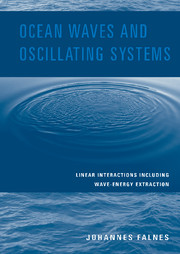Book contents
3 - Interaction Between Oscillations and Waves
Published online by Cambridge University Press: 14 May 2010
Summary
There are many different types of waves in nature. Apart from the visible waves on the surface of oceans and lakes, there are, for instance, sound waves, light waves and other electromagnetic waves. This chapter gives a brief description of waves in general and compares surface waves on water with other types of waves. It also presents a simple generic discussion on the interaction between waves and oscillations. One phenomenon is generated waves radiated from an oscillator, and another phenomenon is oscillations excited by a wave incident upon the oscillating system. The radiation resistance is defined in terms of the power associated with the wave generated by an oscillator. For a mechanical oscillating system the “added mass” is related to added energy associated with the wave-generating process, not just to kinetic energy but to the difference between kinetic and potential energies.
Comparison of Waves on Water with Other Waves
Waves on water propagate along a surface. Acoustic waves in a fluid and electromagnetic waves in free space may propagate in any direction in a three-dimensional space. Waves on a stretched string propagate along a line (in a one-dimensional “space”). The same may be said about waves on water in a canal and about guided acoustic waves or guided electromagnetic waves along cylindrical structures, although in these cases the physical quantities (pressure, velocity, electric field, magnetic field, etc.) may vary in directions transverse to the direction of wave propagation.
As was mentioned in Chapter 2, there is an exchange of kinetic energy and potential energy in a mechanical oscillator (or magnetic energy and electric energy in the electric analogue).
- Type
- Chapter
- Information
- Ocean Waves and Oscillating SystemsLinear Interactions Including Wave-Energy Extraction, pp. 43 - 57Publisher: Cambridge University PressPrint publication year: 2002



